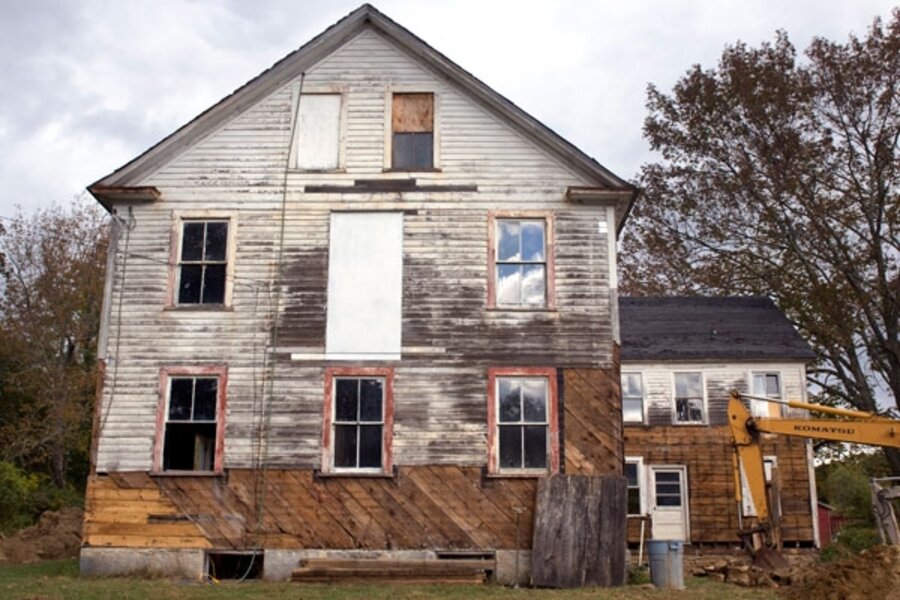A late green bloomer – Sheep Dog Hollow renovation
Loading...
OK, so you’ve decided to take the plunge with me and “go green” – or at least as green as possible.
From my last post, you’re now fully advised that some research and up-front money will be needed. (The cliché that “to go green you’re going to need some green” is too worn for even me to use, alas.)
Now comes the next hurdle, which I confess, I have not read about anywhere else. I call it the “green intimidation factor.”
Suddenly, you realize that while you were simply trying to survive, going about your stressed- out life – paying bills and keeping up with the latest in your profession, politics, and all of the intricate demands of family life – there was thriving subculture of “green believers” busily forging a new path to the future.
These are the people who for the past generation or two have been selflessly putting their ideals first, bucking the nation’s conventional dependence on fossil fuels by honing alternative technologies from organic, high-performance spray-foam insulation to super-efficient solar panels that also operate as roof shingles. (OK, I know some profit motive was also involved.)
Even back in the 1970s we all knew (although most of us conveniently forgot) that we’d have to change our basic relationship to fossil fuels. But after all of the energy tax breaks and incentives from the Carter administration were rolled back, it did take some courage to go a genuine green way.
While I knew on some level that this quiet revolution was going on – I do read the papers – the decision to renovate Sheep Dog Hollow in a green manner brought home vividly how “un-green,” even antediluvian I am, at least in environmental terms.
To put this realization into context, let me assure you that I usually consider myself a well-educated, progressive thinker-type with at least a vague environmental awareness.
I studiously sort my paper, plastics, glass, and metals and recycle them. I’ve always done my best not to waste energy, turning off lights when I leave a room (usually), never turning the heat up too high (unless I was absolutely freezing), and walking instead of driving (which I confess was easy most of the time, since I live mostly in New York City).
But with the limited research I’ve done so far, I now see I wasn’t close to living a even a pale green life – to say nothing of a genuinely green life. And that mortifying realization that you’re really not what you thought you were – at least in environmental terms - is what I call “the green Intimidation factor.”
After a day or two of feeling fairly inadequate, wasteful, and like an unrecovered oil addict, I decided that the best way to deal with it was to simply get over it and get on with it.
And this brings me to LEED and the US Green Building Council. It’s a nonprofit group of community leaders in the environmental and building trades that has been working for years to make going green easy – and, some day, genuinely affordable. Its goal is stated simply: “to make green buildings available to everyone within a generation.”
This is the group that pioneered the first “green rating” system (which is called LEED, for Leadership in Energy and Environmental Design) that is now generally accepted as the gold standard – or platinum, as it were – of energy-efficient building.
Think of it as a more sophisticated “Good Housekeeping Seal of Approval.”
The group's site is full of vital information – such as how to go about contacting green building experts, where to find green building products and lists of available courses as well as lots of fun facts about the impact of going green.
For instance, did you know that: “Buildings in the United States are responsible for 39 percent of CO2 emissions, 40 percent of energy consumption, 13 percent of water consumption, and 15 percent of GDP per year, making green building a source of significant economic and environmental opportunity. Greater building efficiency can meet 85 of future U.S. demand for energy, and a national commitment to green building has the potential to generate 2.5 million American jobs.”
Now, unless you’re heavily invested in oil stocks, I think that would be hard to argue with. (But please, do if you’d like to, I’m always willing to learn … post away!)
So no longer suffering from “the green intimidation factor,” I am not only ready, but excited, to move on.
Next: Is It Really Worth It to Hire a Green Expert or Should You Try to Do It Yourself?
Editor's note: Alexandra Marks will be blogging twice a week about her green and budget-friendly restoration of a 1902 farmhouse in Connecticut. See a photo gallery of the early days of the project by clicking here.
You'll find numerous articles about the environment at the Monitor’s main environment page. Also, check out our Bright Green blog archive and our RSS feed.





